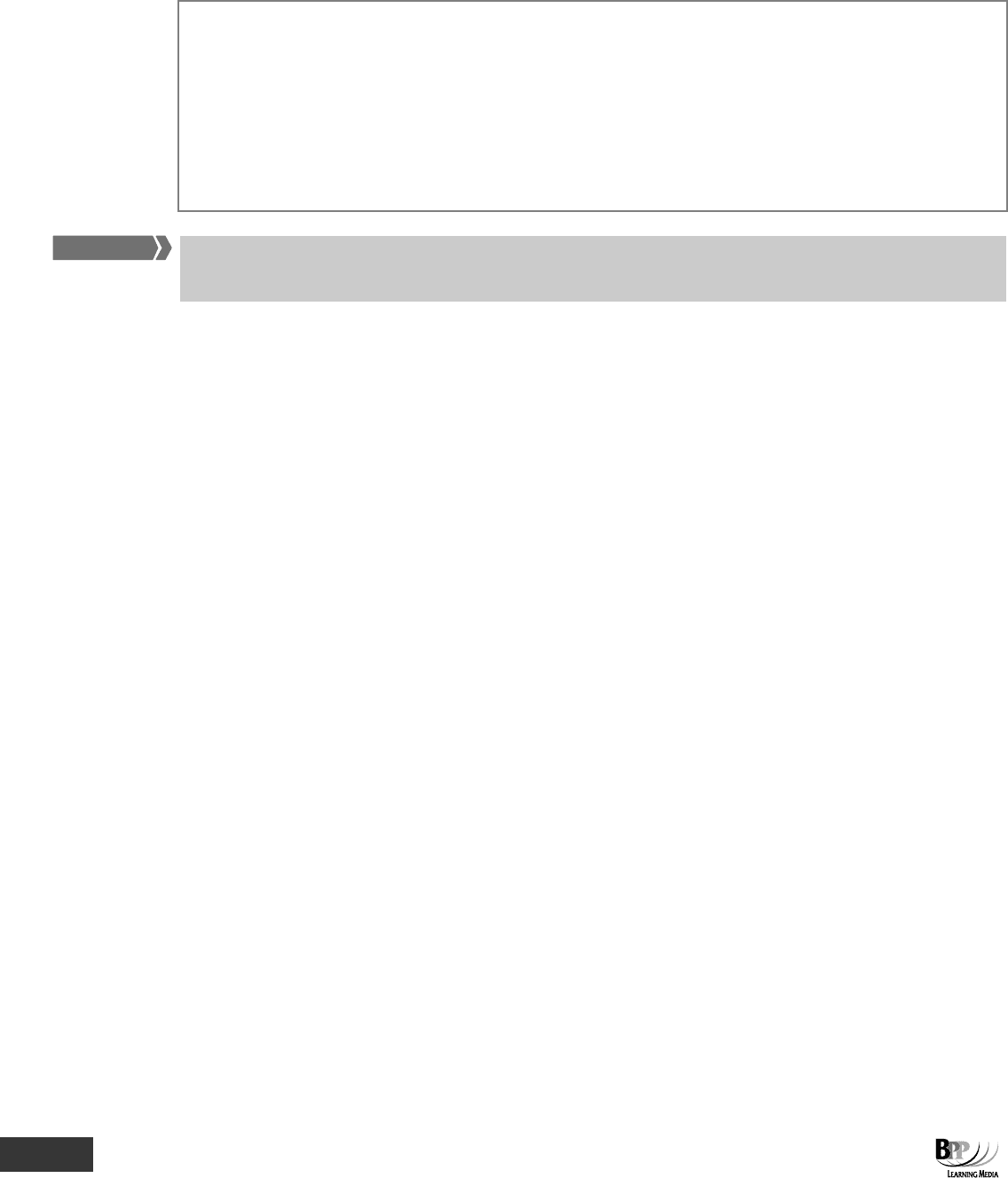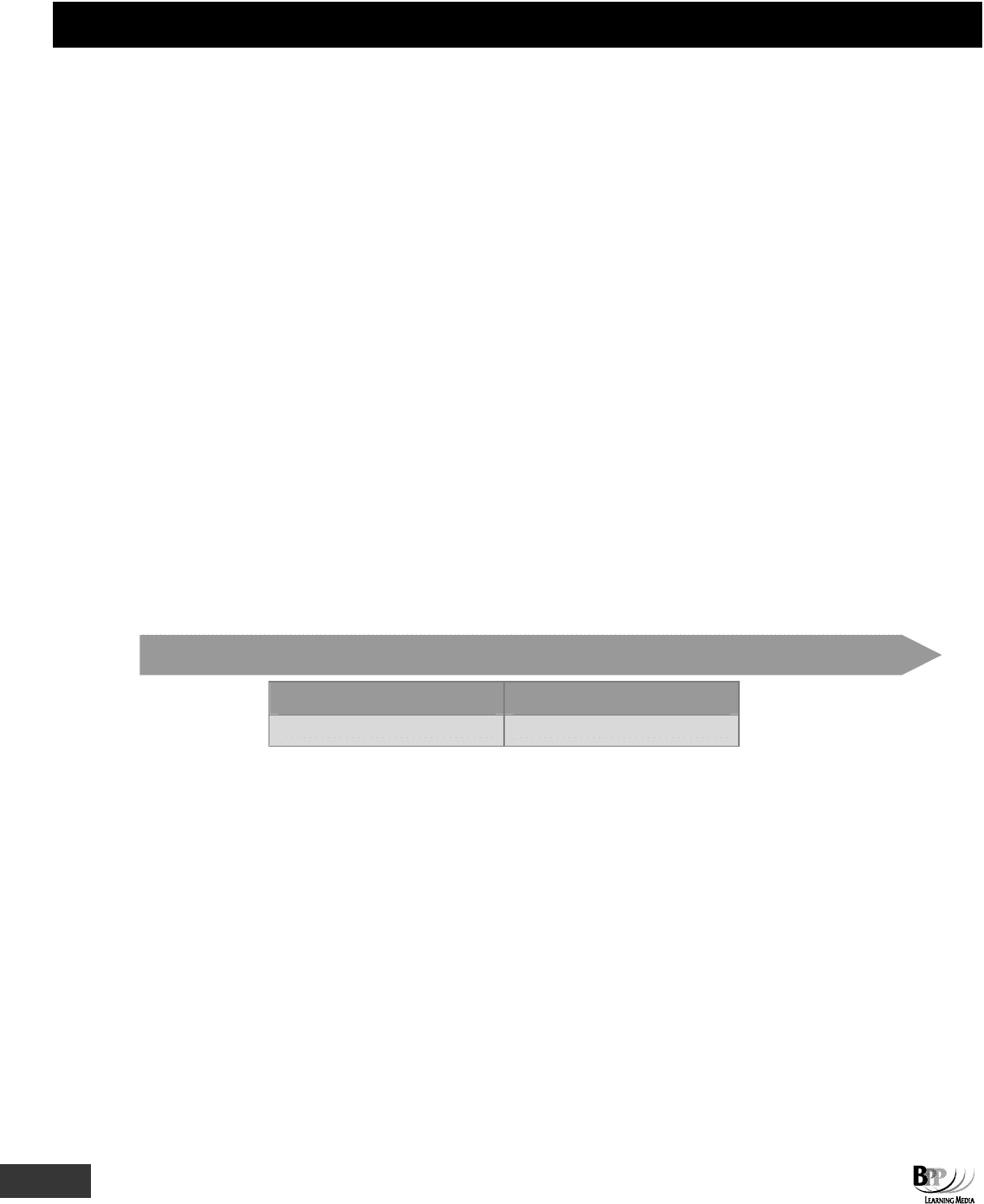CIMA - C2 Fundamentals of Financial Accounting
Подождите немного. Документ загружается.


340 23: Internal and external audit ⏐ Part C Final accounts and audit
9 The detection and prevention of fraud
In Derry v Peek, fraud was defined as: 'a false representation of fact made with the knowledge of its falsity, or without
belief in its truth, or recklessly careless, whether it be true or false'.
The auditing guideline concerns financial fraud, and the definition runs as follows:
'The word 'irregularities' is used to refer to intentional distortions of financial statements, for whatever purpose, and to
misappropriations of assets, whether or not accompanied by distortions of financial statements. Fraud is one type of
irregularity. The word 'fraud' is used to refer to irregularities involving the use of criminal deception to obtain an unjust
or illegal advantage.'
In internal auditing, detection of fraud is an important objective. Auditors should be aware of the common types of fraud
and should be particularly watchful when internal controls are poor.
9.1 Types of fraud
Give an employee responsibility, and he may manage the resources under his control dishonestly. The incidence of
financial fraud, particularly in a computer environment, is increasing fast. This trend, together with the increasing
sophistication of fraudsters, creates difficult problems for management and for internal auditors.
The mere presence of internal auditors will serve to discourage fraudsters for fear of being discovered, but the public
's
expectations go much further.
The profession has responded in a number of ways, not least the issue of the Auditing Practices Board
's standard ISA
240 The auditor's responsibilities relating to fraud in an audit of financial statements (October 2009).
The auditors will best be able to detect frauds if they are knowledgeable (not experienced!) in the most common
methods of fraud. These are as follows.
• Ghost employees on the payroll
• Miscasting of the payroll
• Stealing unclaimed wages
• Collusion with external parties
• Teeming and lading
• Altering cheques after signature
• Inflating expense claims
• Using the company
's assets for personal gain
• Stealing fully depreciated assets
• Issuing false credit notes or fraudulently writing off debts
• Failing to record all sales
Ghost employees. These are imaginary employees for whom the wages department prepare wage packets which are
distributed amongst the fraudsters. This type of fraud arises when there is extensive reliance on casual workers, and
minimal record keeping for such workers. Inflated overtime claims can also result from poor time recording systems.
Such frauds can be detected from a review of the numbers of employees required to achieve a standard amount of work.
If at some times of the year a larger number appear to be required, there may be something amiss. Scrutiny of
signatures given as proof of receipt of wages should also be made.
Key term
FA
S
T F
O
RWAR
D
361465 www.ebooks2000.blogspot.com

Part C Final accounts and audit ⏐ 23: Internal and external audit 341
Miscasting of the payroll. This fraud often succeeds due to its simplicity. If there are twenty employees, each to be paid
$100, then the computer program for the payroll could be adjusted so that an extra $50 is added to the total added up
for the amounts to be paid. Thus management approve a payment of $2,050 for the period
's wages, each employee gets
his $100 and the fraudster collects his extra $50. Manual payroll systems can be manipulated in a similar way. When
employees are paid in cash, this type of fraud can be hard to trace and all too easy to perpetrate.
Stealing unclaimed wages is also common. This is effectively confined to wages paid in cash and can occur when an
employee leaves without notice or is away sick. In the case of a subsequent claim for unpaid wages, it could be claimed
that the cash in the original pay packet was paid back into the bank.
Collusion with external parties could involve suppliers, customers or their staff. Possible frauds are overcharging on
purchase invoices, undercharging on sales invoices or the sale of confidential information (eg customer lists, expansion
plans) to a competitor. Management should watch out for unusual discounts or commissions being given or taken, or
for an excessive zeal on the part of an employee to handle all business with a particular company.
Teeming and lading is a
'rolling' fraud rather than a 'one-off' fraud. It occurs when a clerk has the chance to
misappropriate payments from receivables or to payables. Cash received by the company is borrowed by the cashier
rather than being kept as petty cash or banked. (It is also possible, although riskier and more difficult to organise, to
misappropriate cheques made payable to the company.) When the cashier knows that a reconciliation is to be
performed, or audit visit planned, he pays the money back so that everything appears satisfactory at that point, but after
the audit the teeming and lading starts again. Surprise visits by auditors and independent checking of cash balances
should discourage this fraud.
A common fraud arising when one employee has sole control of the sales ledger and recording debtors
' cheques is to
pay cheques into a separate bank account, either by forged endorsement or by opening an account in a name similar to
the employer
's.
The clerk has to allocate cheques or cash received from other receivables against the account of the receivable whose
payment was misappropriated. This prevents other staff from asking why the account is still overdue or from sending
statements etc to the receivables. However, the misallocation has to continue as long as the money is missing. This
fraud, therefore, never really stops. It can be detected by independent verification of receivables balances (eg by writing
to them) and by looking at unallocated payments, if the sales ledger is organised to show this. In addition, sending out
itemised monthly statements to receivables should act as a deterrent, although in a really elaborate fraud the clerk may
be keeping two sets of books, so that the statements show the receivable'
s own analysis of amounts due and paid off in
the month, but do not agree with the books.
Altering cheques and inflating expense claims are self-explanatory.
Using the company
's assets for personal gain and stealing fully depreciated assets are both encountered in practice.
Whether or not the private use of company telephones and photocopiers is a serious matter is up to the company to
judge, but it may still be fraudulent. More serious examples include the sale by employees of unused time on the
computer, which is a growing fraud.
Another way of avoiding detection when cash and cheques received from debtors have been misappropriated is to issue
a credit note which is not sent to the customer (who has paid his account) but is recorded in the books. Again, the issue
of itemised statements monthly should show this up, as the customer would query the credit note. However, any
company with sufficiently lax controls to allow one clerk both to receive and record cash and additionally to authorise
and issue credit notes is unlikely to ensure that someone else issues and follows up statements. A similar tactic is to
write a debt off as bad to cover up the disappearance of the payment.
A very elaborate fraud may be perpetrated in a business with extremely poor controls over sales recording and minimal
segregation of duties. In such circumstances, a dishonest bookkeeper may invoice customers but fail to record the
invoices so that the customer
's payments never have to be recorded and the misappropriation is not missed.
362465 www.ebooks2000.blogspot.com

342 23: Internal and external audit ⏐ Part C Final accounts and audit
This type of fraud can occur where a customer is receiving large numbers of invoices from the business every month
and so the bookkeeper
's failure to record one or two invoices (if detected by auditors or his superiors) is simply put
down to incompetence rather than fraud.
A warning sign here is the perception by customers that
'your accounts department is a mess ... always getting things
wrong ... we
've given up trying to get our account right...'.
9.2 The role of the internal auditors
The internal auditors should start their work by identifying the areas of the business most susceptible to fraud. These will
include areas where cash is involved, and the other areas where the auditors
' judgement is that the internal controls are
insufficient to safeguard the assets.
The existence of a properly functioning system of internal controls will diminish the incidence of frauds, so the auditors
'
opinion on the internal control system is of fundamental importance.
Whenever a fraud is discovered, they should judge whether a weakness in internal controls has been highlighted, and if
so what changes are needed.
9.3 Prevention of fraud
Fraud will only be prevented successfully if potential fraudsters perceive the risk of detection as being high, and if
personnel are adequately screened before employment and given no incentive to turn against the company once
employed. The following safeguards should therefore be implemented.
(a) A good internal control system.
(b) Continuous supervision of all employees.
(c) Surprise audit visits.
(d) Thorough personnel procedures.
The work of employees must be monitored as this will increase the perceived risk of being discovered. Actual results
must regularly be compared against budgeted results, and employees should be asked to explain significant variances.
Surprise audit visits are a valuable contribution to preventing fraud. If a cashier is carrying out a teeming and lading
fraud and is told that an audit visit is due the following week, he may be able to square up the books before the visit so
that the auditors will find nothing wrong. But if the threat of a surprise visit is constantly present, the cashier will not be
able to carry out a teeming and lading fraud without the risk of being discovered, and this risk is usually sufficient to
prevent the fraud.
The auditors do not need to carry out any sophisticated audit tests during their surprise visit. There are stories of internal
auditors arriving without warning, and taking all the books into a room of their own to read the newspaper for an hour –
but the fraud deterrent effect on the employee is highly significant, because the employee thinks that every figure is
being checked.
Finally, personnel procedures must be adequate to prevent the occurrence of frauds.
(a) Whenever a fraud is discovered, the fraudster should be dismissed and the police should be informed. Too
often an employee is
'asked to resign' and then moves on to a similar job where the fraud is repeated,
often because management fear loss of face or investor confidence. This is a self-defeating policy.
(b) All new employees should be required to produce adequate references from their previous employers.
(c) If an employee
's lifestyle changes dramatically, explanations should be sought.
363465 www.ebooks2000.blogspot.com

Part C Final accounts and audit ⏐ 23: Internal and external audit 343
(d) Every employee must be made to take his annual holiday entitlement. Sometimes in practice the employee
who is
'so dedicated that he never takes a holiday' is in fact not taking his leave for fear of his fraud being
discovered by his replacement worker while he is away.
(e) Pay levels should be adequate and working conditions of a reasonable standard. If employees feel that
they are being paid an unfairly low amount or
'exploited', they may look for ways to supplement their pay
dishonestly.
9.4 Management fraud
So far, this chapter has concentrated on employee fraud. However, arguably more serious (and very much more difficult
to prevent and detect) is the growing problem of management fraud.
While employee fraud is usually undertaken purely for the employee
's financial gain, management fraud is often
undertaken to improve the company
's apparent performance, to reduce tax liabilities or to improve manager's promotion
prospects.
Managers are often in a position to override internal controls and to intimidate their subordinates into collusion or
turning a blind eye. This makes it difficult to detect such frauds. In addition, where the company is benefiting financially
rather than the manager, it can be difficult to persuade staff that any dishonesty is involved.
This clash of interest between loyalty to an employer and professional integrity can be difficult to resolve and can
compromise an internal auditor
's independence.
Management fraud often comes to light after a take-over or on a change of audit staff or practices. Its consequences can
be far reaching for the employing company in damaging its reputation or because it results in legal action. Because
management usually have access to much larger sums of money than more lowly employees, the financial loss to the
company can be immense.
364465 www.ebooks2000.blogspot.com

344 23: Internal and external audit ⏐ Part C Final accounts and audit
Chapter roundup
• It is important to distinguish between ownership and stewardship.
• External auditors report to the members of the company on whether, in their opinion, the annual statutory accounts give
a true and fair view. Their duties are imposed by statute and they are not employees of the company. Under International
Accounting Standards, auditors report on 'fair presentation'.
• 'True and fair' is not defined in company law or accounting standards. The words are used together rather than
separately and the term is generally taken to mean 'reasonably accurate and free from bias or distortion'. Under IAS, the
term is 'fair presentation'.
• Internal auditors are employees of the company whose duties are fixed by management and who report to management.
• The scope of an internal audit varies widely and may range from systems review to implementation of corporate policies,
plans and processes.
• Contrary to popular belief, it is not the responsibility of external auditors to detect fraud; they are merely obliged to plan
their audit tests so that they have a reasonable expectation of detecting fraud. It is the responsibility of the directors to
set up an adequate system of internal control to deter and expose fraud. Internal audit is one type of internal control.
• The eight types of internal control can be remembered by using the mnemonic SPAMSOAP.
• There are three separate elements into which sales accounting controls may be divided. They are selling (authorisation),
goods outwards (custody) and accounting (recording).
• There are also three separate elements into which accounting controls may be divided in the consideration of purchase
procedures. They are buying (authorisation), receipt of goods (custody) and accounting (recording).
• Internal controls need to be evaluated for adequacy and risk.
• In general terms an audit trail is a means by which an auditor can follow through a transaction from its origin to its
ultimate location or vice versa.
• In internal auditing, detection of fraud is an important objective. Auditors should be aware of the common types of fraud
and should be particularly watchful when internal controls are poor.
365465 www.ebooks2000.blogspot.com

Part C Final accounts and audit ⏐ 23: Internal and external audit 345
Quick quiz
1 The auditor's report states whether the financial statements give a 'true and fair' view. True and fair has never been
statutorily defined. True or false?
2 To whom should the head of internal audit report in a large company?
A The finance director
B The chief accountant
C The chairman of the board of directors
D The external auditors
3 Which of the following statements concerning the status of an external auditor is incorrect?
A All companies must appoint external auditors
B The duties of an auditor are defined by the Companies Act 2006
C The auditor gives an opinion on the financial statements
D The auditor reports to the members of the company
4 Which of the following procedures is unlikely to be encountered in following through an 'audit trail' in a computerised
accounting system?
A The authorisation of input documents
B One for one checking of master file amendments
C Output being completely checked against input data in a system producing budgetary control reports
D Authorisation of changes to a computer program
5 What is a 'teeming and lading fraud'?
A Stealing cash
B Colluding with external partners to submit false invoices
C Stealing cash, concealing the theft by delaying bankings or making good the shortage by transfers from other
sources
D Altering cheques and cash receipt records to record lesser amounts and pocketing the difference
366465 www.ebooks2000.blogspot.com

346 23: Internal and external audit ⏐ Part C Final accounts and audit
Answers to quick quiz
1 True
2 C Correct. This is ideal, an alternative would be to report to the board or an audit committee.
A Independence will be compromised and recommendations possibly diluted.
B The chief accountant may lack authority to implement the needed changes following an internal audit review and
independence may be compromised.
D The external auditors must not be involved in executive decisions within a client, otherwise their independence
could be compromised.
3 A Correct. Small limited companies and unincorporated businesses or partnerships need not have an external audit.
4 C Correct. It is more usual to find output on a exceptions basis, such as the investigation of significant variances in
the example given.
A A key element of control over input, difficult to achieve in on-line or real-time systems.
B An important procedure to preserve the integrity of master file data.
D This would be present in the systems documentation.
5 C Correct. The characteristics of this type of fraud are theft (or 'borrowing') coupled with a scheme to conceal
typically involving delayed bankings.
A The objective of a teeming and lading fraud is to misappropriate cash, it is how it is concealed which is unique.
B This is not a teeming and fraud, although it is a common type of fraud.
D This is a straightforward receipts fraud.
Now try the questions below from the Question Bank
Question numbers Page
101–114 410
367465 www.ebooks2000.blogspot.com

347
Part D
Interpretation of accounts
368465
www.ebooks2000.blogspot.com

348
369465 www.ebooks2000.blogspot.com

349
Topic list Syllabus references
1 IAS 7 Statement of cash flows D (11)
2 Prep ari ng a statement o f cash flows D (11)
Statements of cash
flows
Introduction
In the long run, a profit will result in an increase in the company's cash balance but, as
Keynes observed, 'in the long run we are all dead'. In the short run, the making of a profit
will not necessarily result in an increased cash balance. The observation leads us to two
questions. The first relates to the importance of the distinction between cash and profit. The
second is concerned with the usefulness of the information provided by the statement of
financial position and income statement in the problem of deciding whether the company
has, or will be able to generate, sufficient cash to finance its operations.
The importance of the distinction between cash and profit and the scant attention paid to
this by the income statement has resulted in the development of statements of cash flows.
This chapter adopts a systematic approach to the preparation of statements of cash flow in
examinations; you should learn this method and you will then be equipped for any problems
in the exam itself.
370465 www.ebooks2000.blogspot.com
